Payments
Pelcro provides you with various supported payment options and methods that can cater to your different locations, customers, and business needs. This gives your customers the flexibility to selectively use multiple and alternative options for diverse purchases and payment activities, and provides you with a reliable payment system that streamlines a steady revenue stream.
Payment Methods
Pelcro provides multiple methods for end-users to make payments online. We've integrated with the best payment gateways to make charging for subscriptions, invoices, e-commerce orders, and more trivial for you. All the payment methods below are available via the platform, API, and user interface libraries.
Cards
Pelcro supports all the major card networks listed below by default via our default card forms and fields that are powered by Stripe by default. You can test all payment cards and methods by referring to our Testing documentation.
- Visa
- Master Card
- American Express
- Discover (USD only)
- Diners Club (USD only)
- JCB (USD only)
You (or your end customers) can add up to 200 payment methods under their account at any given time.
Direct Debit
BACS through Stripe
Pelcro supports Direct Debit (BACS) payments for UK customers alongside credit cards. Here's what you need to know about BACS transactions:
- To debit an account, businesses must collect a mandate from their customers. The mandate includes the customer’s sort code, account number, name, email, and full address.
- Direct Debit is a reusable, delayed notification payment method. That means it takes 3 business days to confirm the success or failure of a payment when a mandate is already in place, but when you must collect a new mandate, it can take 6 business days.
- To accommodate BACS processing times, Pelcro will extend your subscription trial period if necessary. The subscription will be activated upon successful payment confirmation. For subscriptions with a trial period, Pelcro will consider the longer of the two durations before activating the subscription.
- Mandate Handling: Pelcro takes care of handling mandates, ensuring secure and authorized Direct Debit transactions.
ACH through Stripe
Pelcro supports ACH Direct Debit payments for U.S. customers through Stripe, in addition to credit cards. Here's what you need to know about ACH transactions:
- Mandate Collection: To debit a bank account, businesses must collect authorization from the customer. This includes the customer's routing number, account number, name, email, and billing address.
- Payment Confirmation Timeline: ACH is a reusable, delayed notification payment method. Once a mandate is in place, it typically takes 3–5 business days for Stripe to confirm the success or failure of an ACH payment.
- Trial Period Accommodation: To accommodate ACH processing times, Pelcro will automatically extend the subscription trial period if needed. The subscription will be activated once the payment is successfully confirmed. If a trial already exists, Pelcro will use the longer of the two periods (trial or ACH confirmation delay) before activation.
- Mandate Handling: Pelcro securely manages ACH mandates and authorization flows to ensure compliance and safe processing.
Digital wallets
Pelcro supports other digital wallets such as Apple Pay and Google Pay. However, additional verification steps are required to use them with Pelcro.
- Apple Pay
- Google Pay
- Paypal
Apple Pay Setup
Available for specific payment gatewaysThis settings is currently only available for the following payment gateways: Stripe and WorldPay (Vantiv) .
Stripe
Enabling Apple Pay for Stripe payment gateway can be achieved by a single click of a button. Proceed to your site settings, enable Apple Pay by clicking on the checkbox and saves your changes.
For this to work, the Site Link in your settings must match the exact domain you plan to use (e.g., https://www.yourdomain.com). Our system will use this URL to automatically register your domain with Stripe. If you need to add or remove domains later, you can manage them directly from your Stripe dashboard.
Vantiv
Apple Pay setup for WorldPay (Vantiv) requires a manual setup. Contact us for more information.
Google Pay Setup
There are no steps required for you to set up Google Pay, yet the following conditions must be met in order for your end-users to be able to see and use Google Pay as payment option in your UI:
- Google Pay is supported in the end-user's country
- Card is valid and was verified under the end-user's Google account
- The option "Allow sites to check if you have payment methods saved" must be enabled in the browser
- The verified card must be displayed under the "Payment methods" section in payment settings of the browser
- Any browser extension which may prevent Google Pay button from showing may have to be disabled or their settings modified (including but not limited to: Dashlane, uBlock Origin, AdBlock/AdBlock Plus, Privacy Badger, Ghostery)
Here's a sample of the chrome://settings/payments settings page, displaying a working setup:
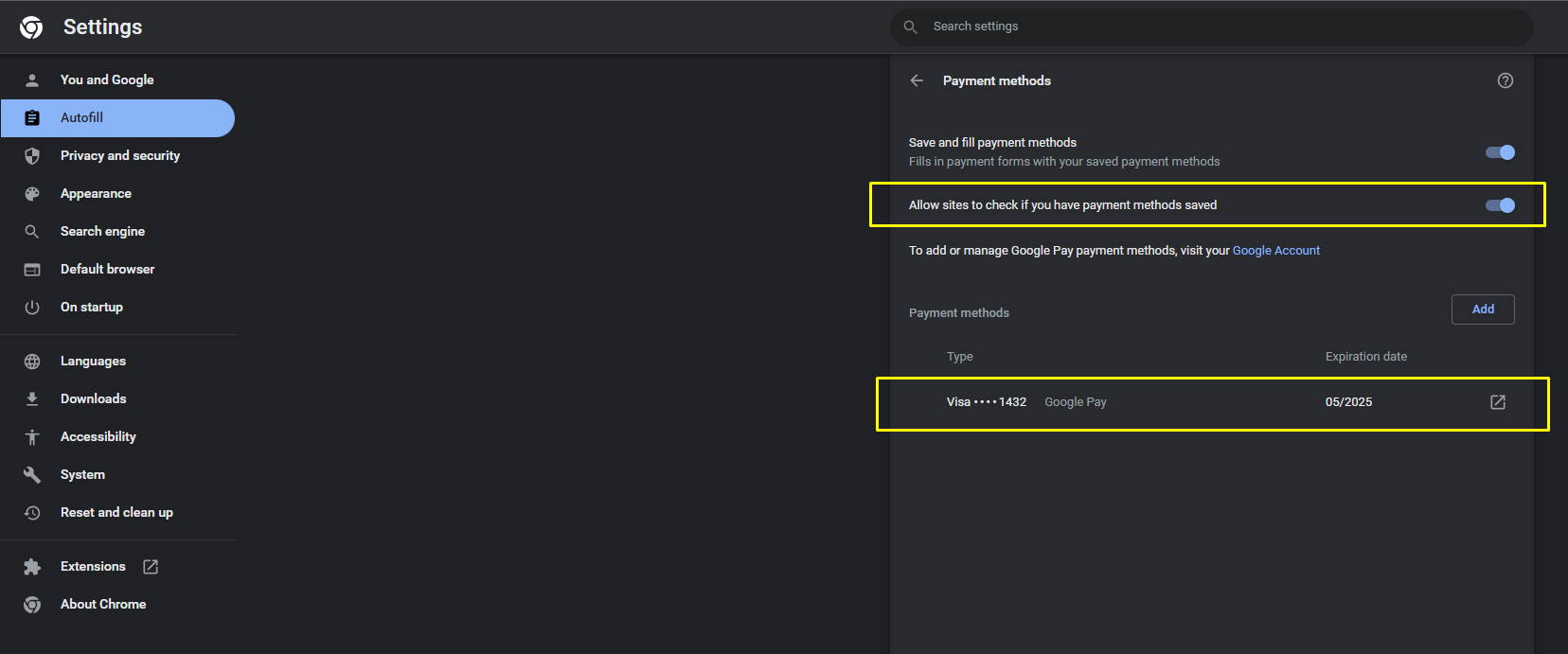
Offline
Pelcro supports offline payments in the form of cash or check. Processes are implemented across the platform to ensure all the necessary information is collected for an offline transaction. For example, a reference check is required when depositing a check.
- Cash
- Check
- Wire transfer
Payment Actions
Listing Payments
To view your payments:
- On your Dashboard, hover over your left navigation menu. Choose "Billing" > "Payments".
- You'll be redirected to the payments page, where you can view and manage all your current customer payments.
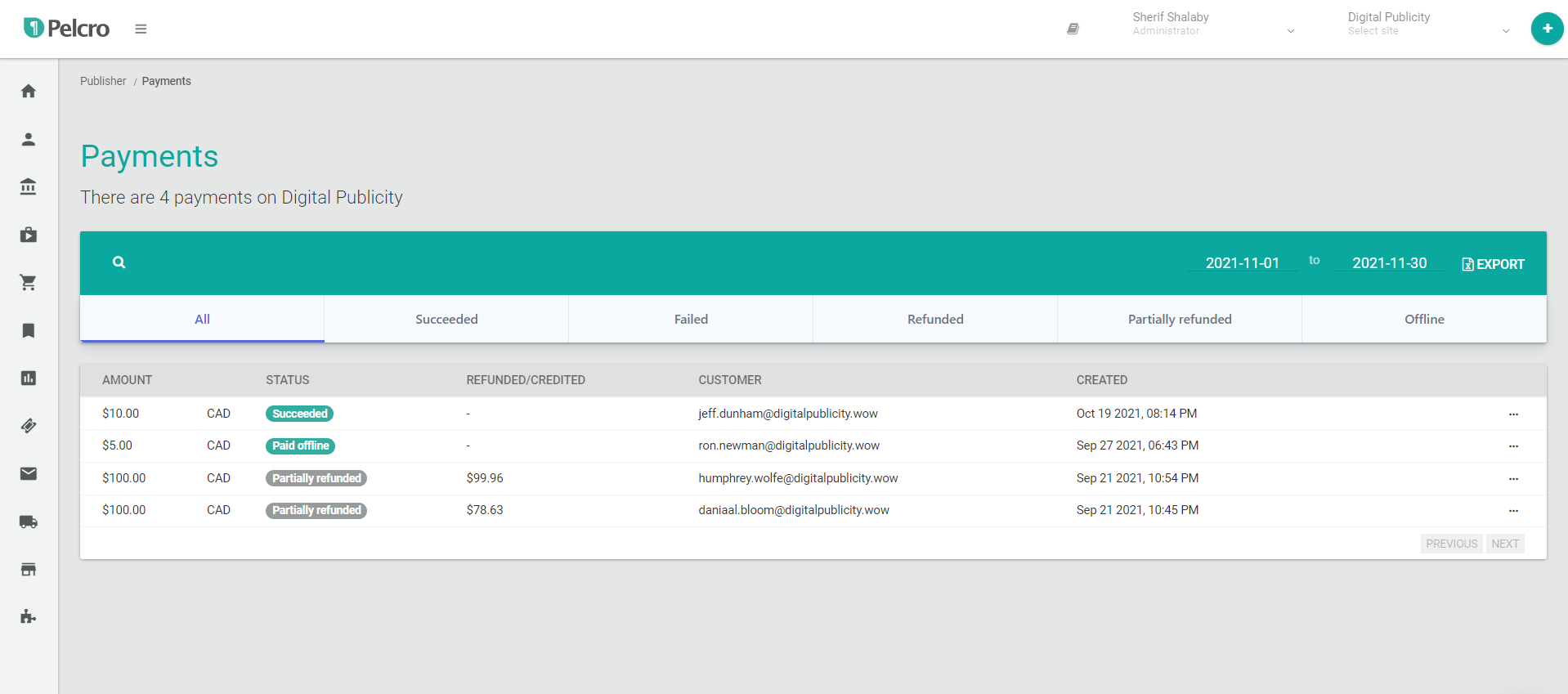
Once you arrive at the payments page, you will see a detailed list view of all payments to your subscriptions and orders, categorized into six different tabs:
- All: These are all of the payment transactions which have been logged for your customers.
- Succeeded: These are payment transactions which have completed successfully.
- Failed: These are payment transactions which have failed to complete due to insufficient funds, invalid payment source, etc.
- Refunded: These are payment transactions which have been fully refunded back to the customer as a result of cancellation on applicable subscriptions and orders.
- Partially refunded: These are payment transactions which have been partially refunded back to the customer as a result of cancellation on applicable subscriptions and orders, with prorations applied.
- Offline: These are payment transactions made via cash, checks, bank transfers, postal orders, or any other offline means besides online payment methods such as cards, digital wallets, etc.
To help navigate you through your payments, you will also find the following:
- Search button: The search button will allow you to directly find a payment based on a number of options. You may search payments by the customer's name, email address, phone number, company, or department.

- Export button: Allows you to export your payments list, along with all the listed details into CSV format. You can control the range of the payment data to export using the date filters in the top right.
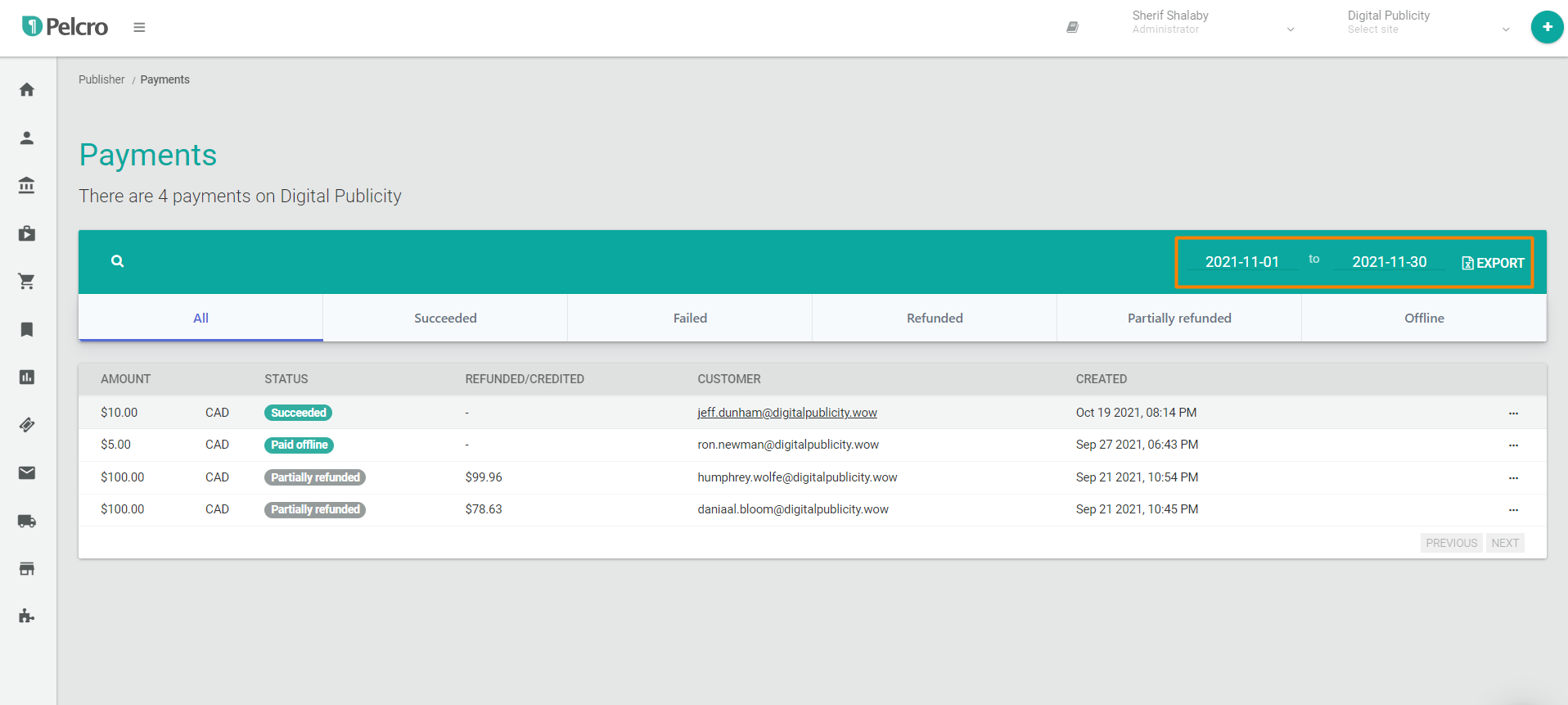
Viewing Payment Details
If you want to view more details of a specific payment, either click on the payment amount line item, or alternatively on the ellipsis "···" menu to the right-most column of the desired payment, followed by "View payment".

The payment details page will contain details related to the transaction, including:
- Date: date when the payment transaction was logged on the platform.
- Customer: customer account which the payment transaction originated from.
- Payment Method: payment method which was used to complete the transaction (Card/Digital Wallet/Offline).
- Risk Evaluation: the risk level for each payment to predict whether a payment is likely to be fraudulent.
- Amount: amount which was charged within the payment transaction from customer payment method.
- Currency: currency for the payment transaction and amount.
- Statement descriptor: information that help customers understand their bank/card statements.
- Status: status of the payment transaction (succeeded, failed, etc.)
- Description: information that help customers understand what this payment is tied to on the platform (e.g. subscription creation, subscription cancellation, etc.)
- Receipt URL: a secure, private URL where your customers can view and download PDF copies of the receipt.

You can also view more details of Pelcro components which are related to payments, such as the associated customer with the payment. To do so, click on the three dots "···" menu to the right-most column of the desired payment, followed by "View customer".
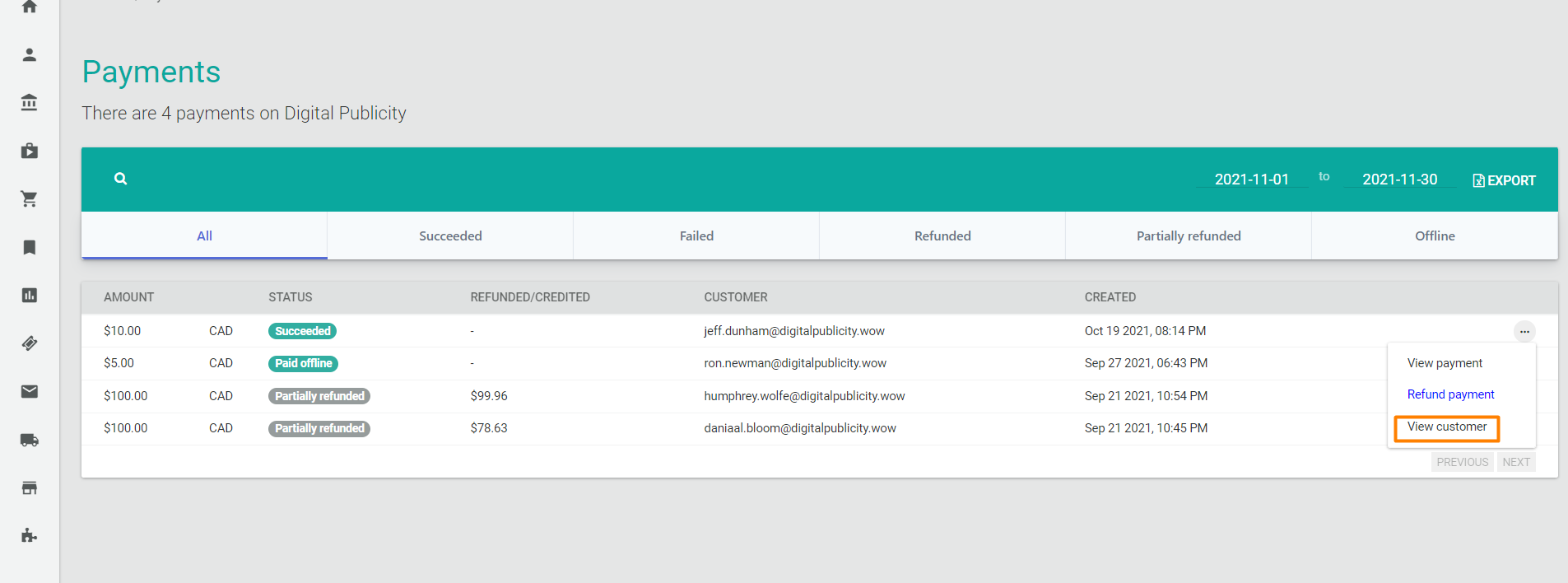
- For more information on Customer Details page, please refer to the Customer documentation.
Creating Payments
Online Payments
Payments will be generated on Pelcro when users either subscribe to your products and service offerings or buy an eCommerce product. There are a number of ways through which users can make payments:
1. Through the platform:

When your collaborators create subscriptions manually for your users through the platform, you can make a payment directly through the platform. You can select different payment methods, such as Credit card payment, Offline payment, or to directly invoice the customer.
At the Payment section you'll have the options to:
- Automatically charge a payment source on file, under which you'll be able to select one of your stored payment information through your payment gateway from a dropdown.
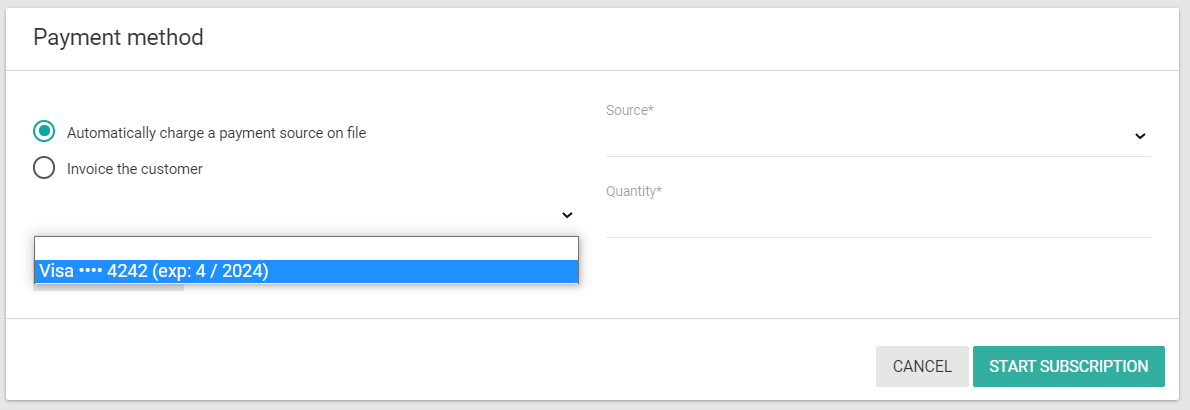
- Add a new card on file which you can use to pay for the subscription
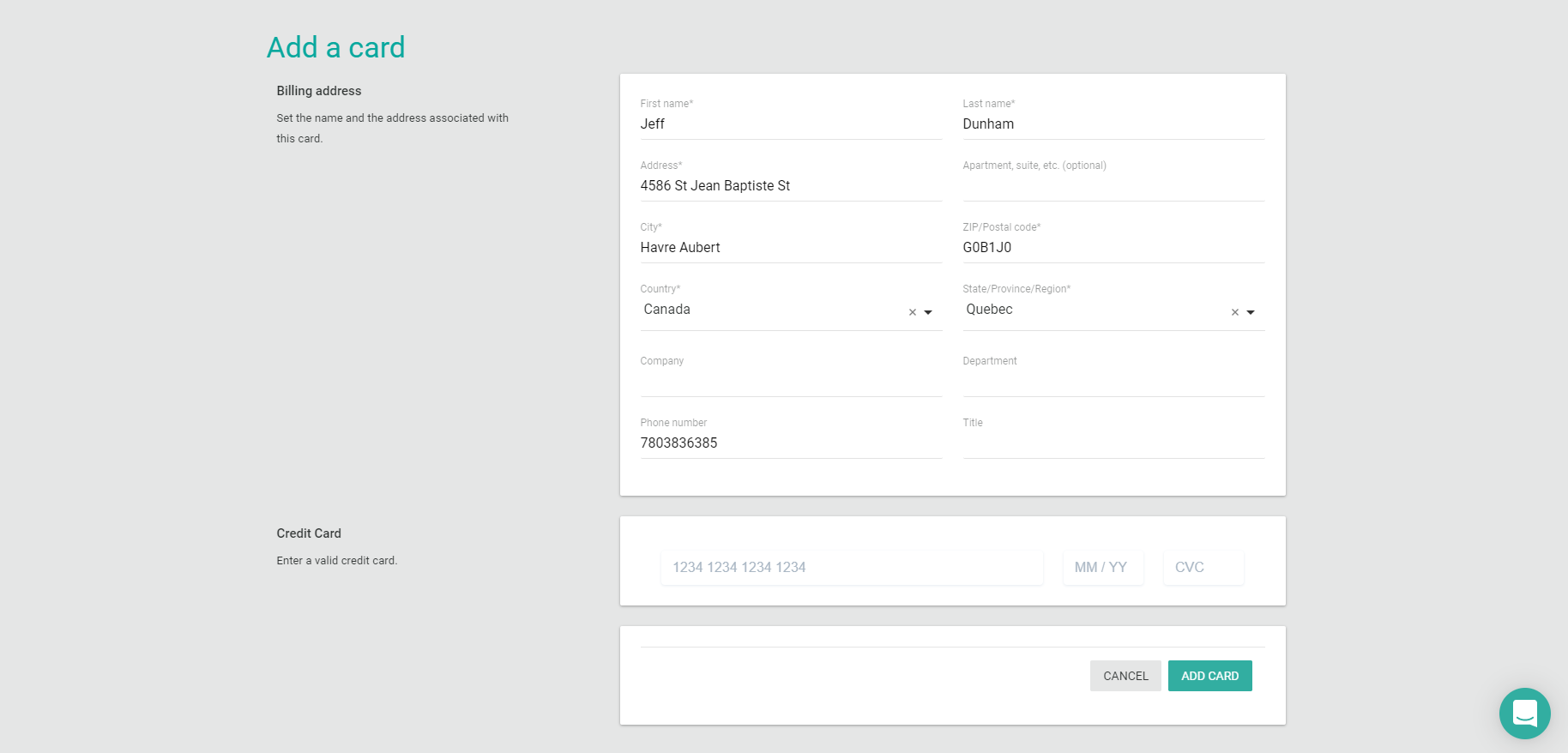
- Or, invoice the customer directly and receive payment via cash, checks, bank transfers, postal orders, or any other offline means.
2. Through your website:
- Your customers can also make payments directly through your website when they are signing up, subscribing to one of your products or services, or purchasing an eCommerce order during the checkout process.
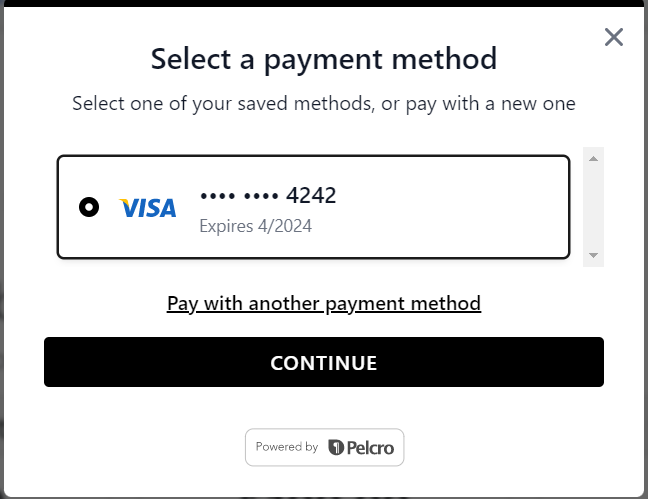
Payments will be reflected directly on the platform. Using either our default payment modals and components, or even custom ones. Find out more by checking out our React elements which you can plug and play directly.
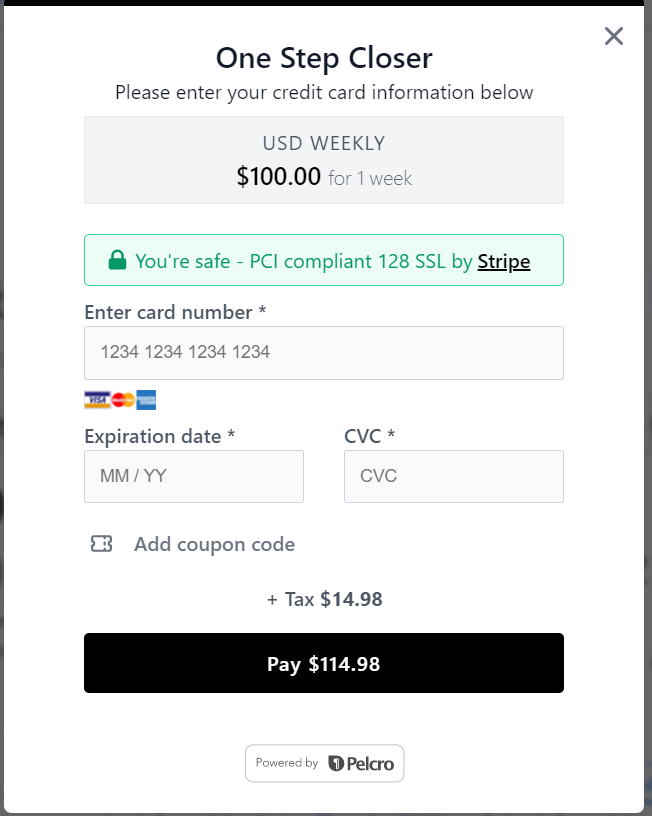
Offline Payments
You can create an offline payment record through your platform for transactions made via cash, checks, bank transfers, postal orders, or any other offline means besides online payment methods such as cards, digital wallets, etc.
- Navigate to the relevant customer details page. Under the payment tab, click the "+" icon.
- Enter the amount, category, currency, and reference details, and click "Enter payment"
- The payment will be reflected on your payments list, as well corresponding payment details page for the customer
- Note that in order for an offline payment to be applied to an invoice, it needs to be entered before the invoice is created and hence before the subscription is created.
- Offline payments can also be entered by navigating to the invoice and marking it as paid - a payment reference will be required and once entered, an offline payment that equals the amount due will automatically be entered into the customer's account.
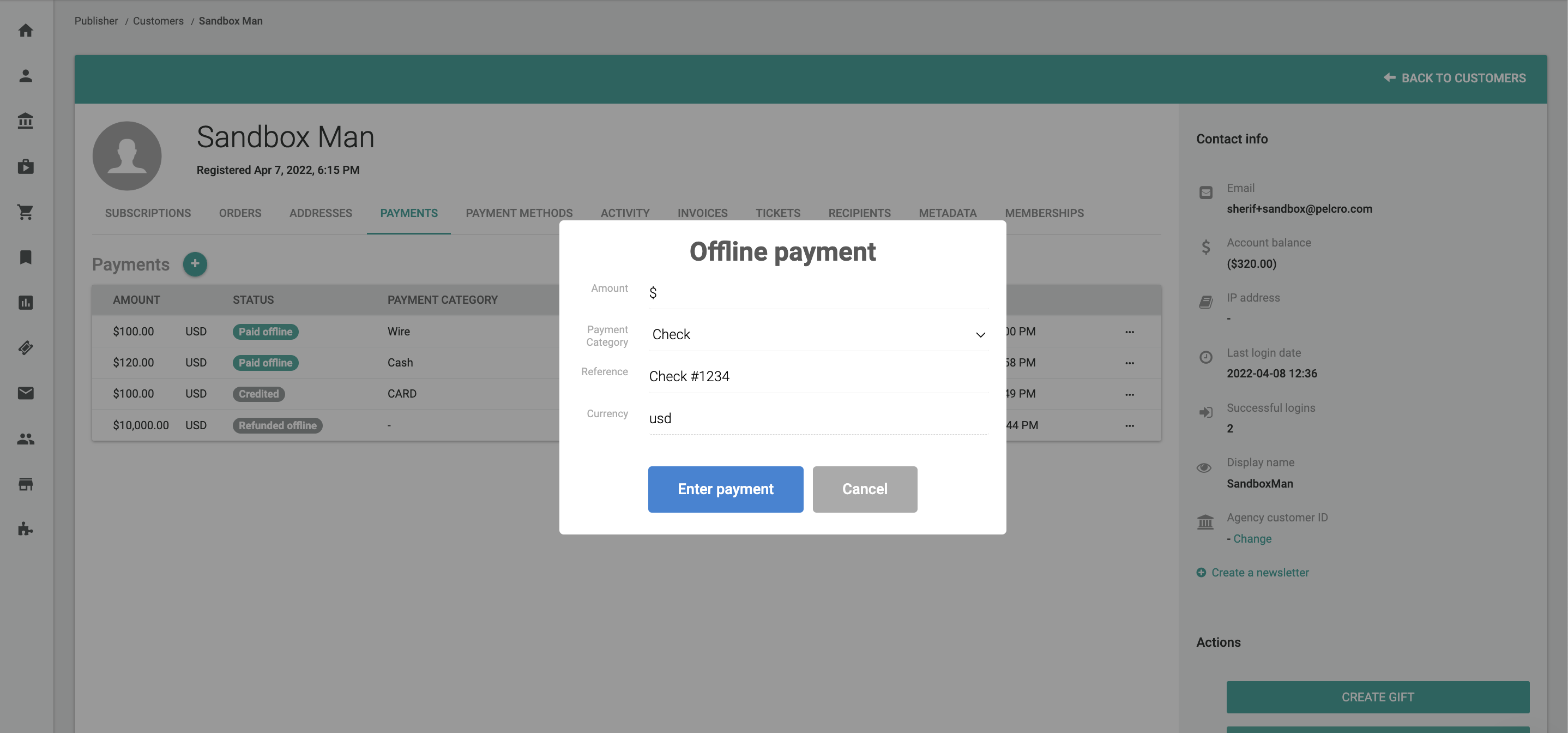
Refunding Payments
You can directly issue a refund through the platform for charges made to a customer's credit card or their offline payment. For more details, please refer to our refunds section.
Payment Method Actions
Listing payment methods
1. Through your platform:
Navigate to the 'Customers' section, select the customer for whom you want to view their payment methods, go to the 'Payment Methods' tab, and you will find the payment methods listed in the table as shown below.

2. Through your website:
Customers will now have the ability to view a list of all their added payment methods through the Payment Cards section on their dashboard. The default payment method will have a 'Default' tag next to it as shown below.
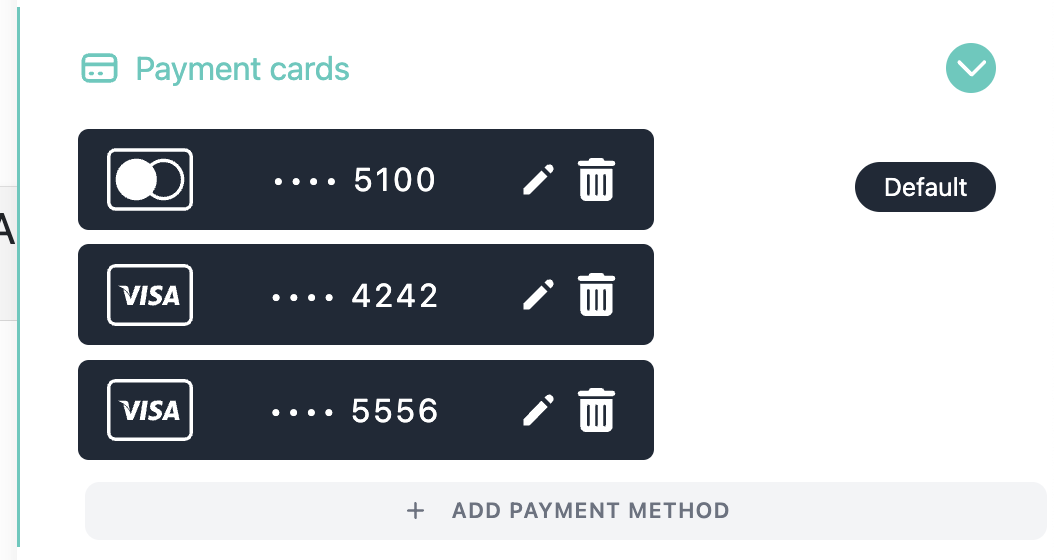
Adding payment methods
1. Through the platform:
Navigate to the 'Customers' section, select the customer for whom you wish to add a payment method, go to the 'Payment Methods' tab, and click on the plus button as shown below.

You will be directed to fill in the credit card information and then proceed to add the card.

2. Through your website:
Customers can add more than one payment method to their account by clicking the 'Add Payment Method' button.
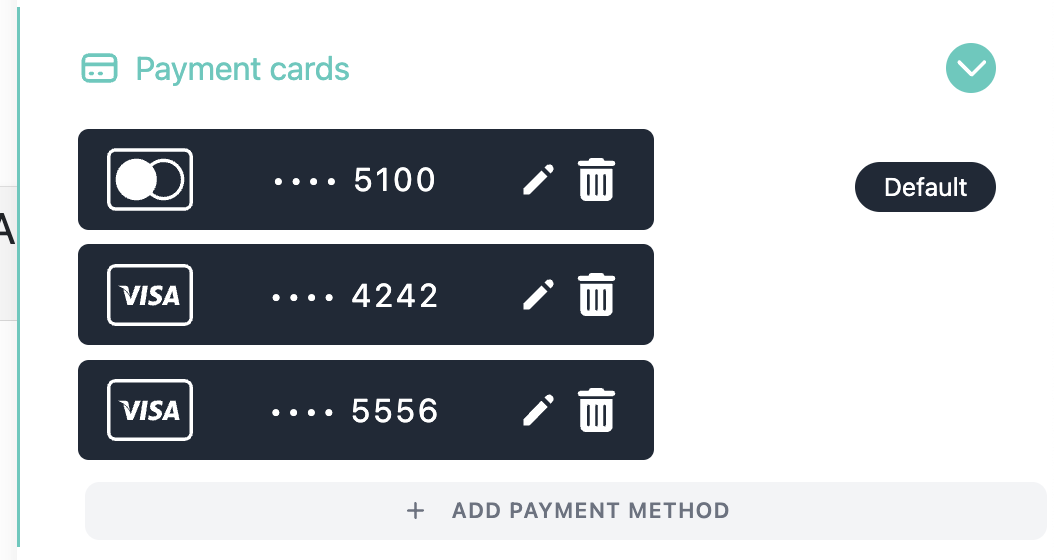
This action will open a pop-up where they can enter their payment details as shown below.

Deleting payment methods
1. Through the platform:
Navigate to the 'Customers' section, select the customer for whom you want to delete a payment method, go to the 'Payment Methods' tab, and click on the ellipsis menu where you will find the 'Delete Card' action, as shown below.
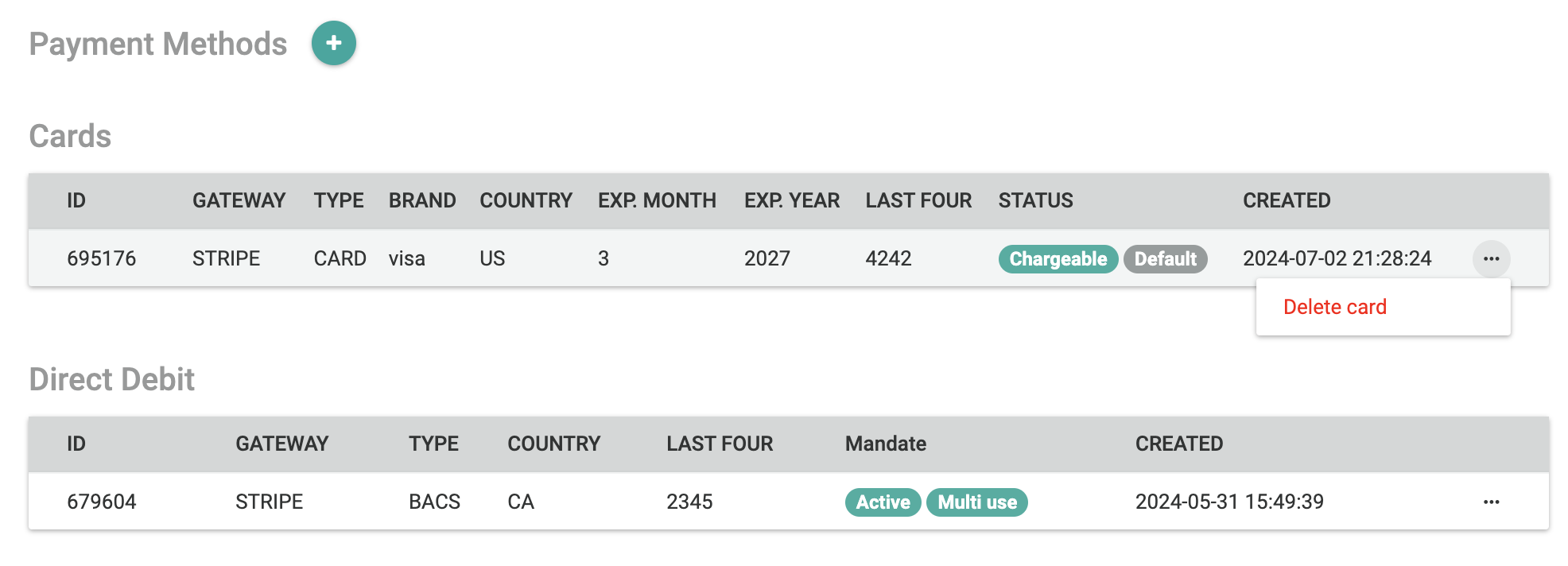
2. Through your website:
By clicking on the delete icon, customers can delete their stored payment methods.

But it's important to note that if a payment method is linked to a pending action or serves as their default payment, the customer will be prompted to either choose an alternative payment method or add a new one before proceeding with the deletion as shown below.
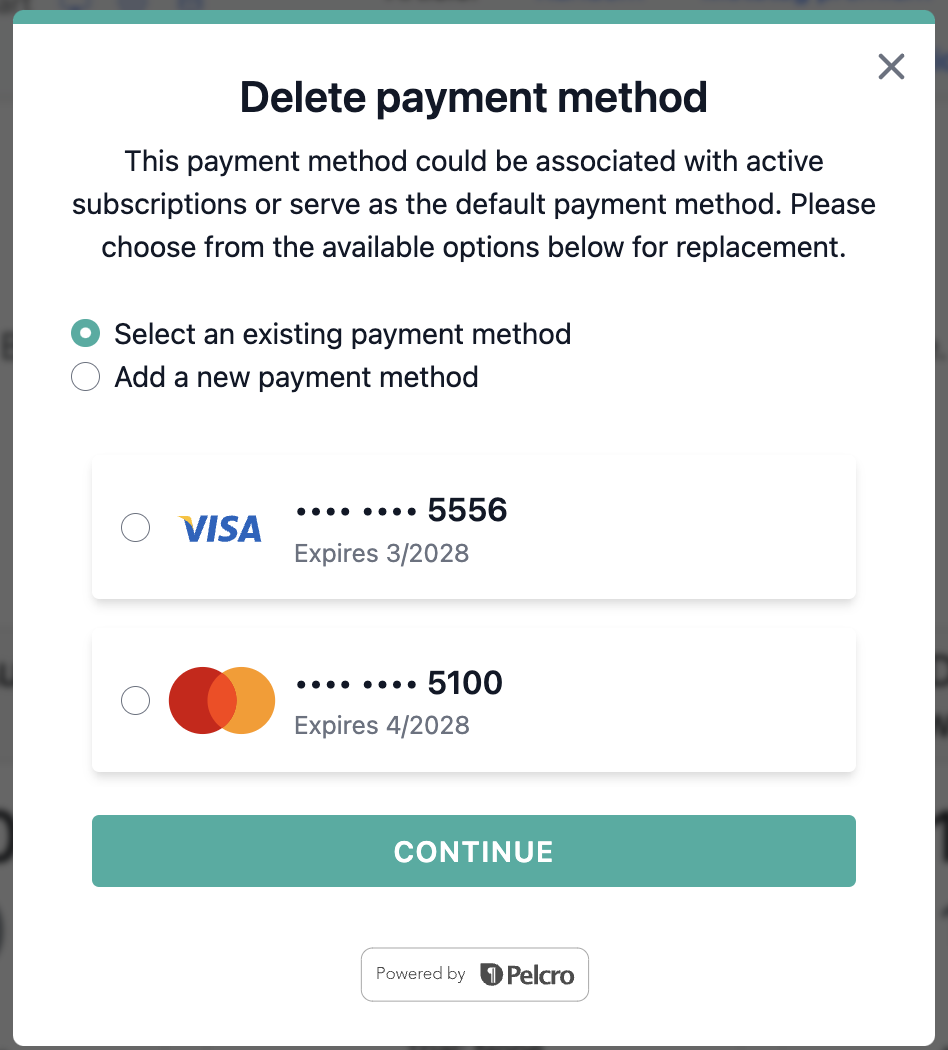
You'll always see a confirmation message showing the payment method details (card type, last 4 digits, expiration date). Note that when you're deleting the default payment method on the account, you'll be prompted to choose a new default payment method in case there are others available.
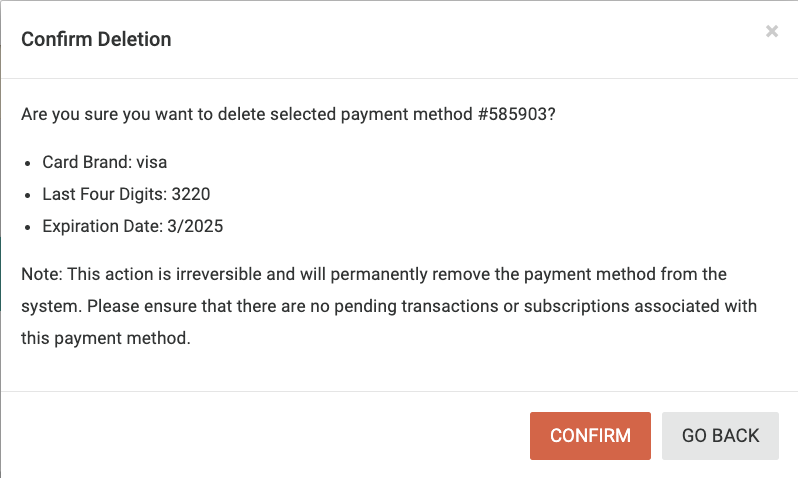
Important: If you need to issue a refund in the future for a payment made with a deleted payment method (cards or digital wallets), you will only credit the customer's account balance on Pelcro.
Updating payment methods
Through your website:
By clicking on the edit icon, customers can modify their stored payment methods as shown below.

When customers click to edit their payment method, a pop-up will appear, allowing them to update the expiration month and year for the payment method as shown below.
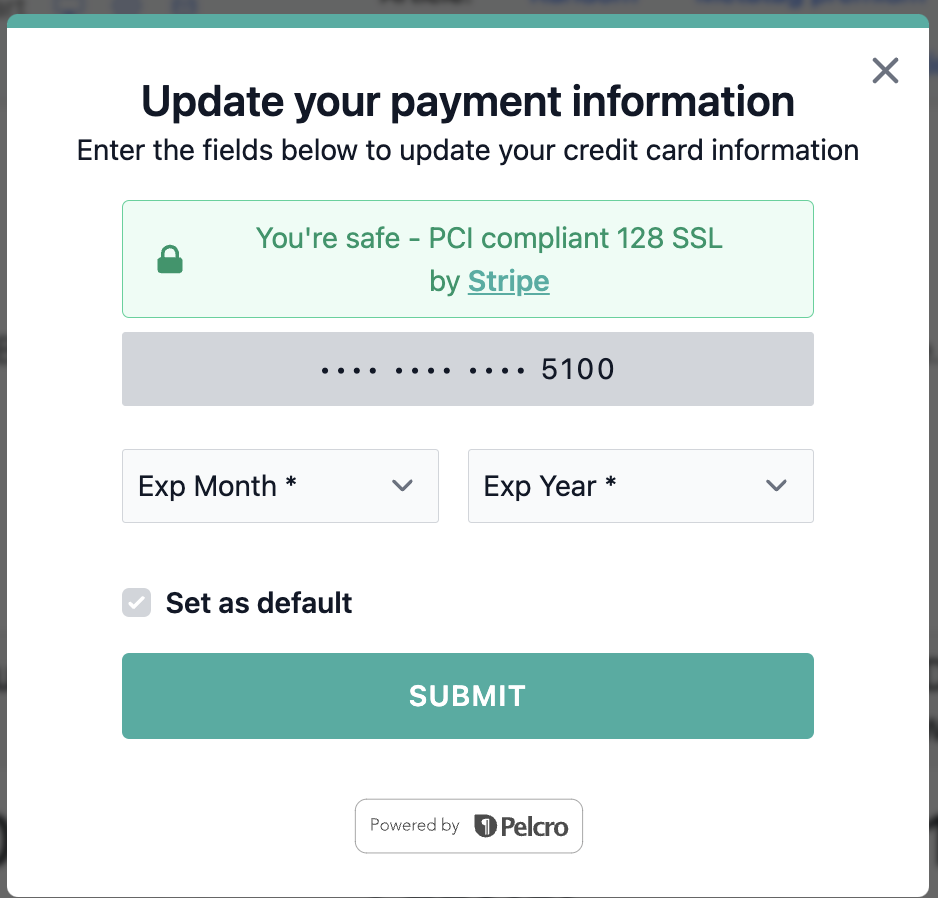
Payment Settings
Payment method expiration notifications

When the option for "Payment method expiration notifications" is enabled within billing settings for your site, webhook notifications are triggered to notify customers if any of their payment methods existing on file will expire at the end of the month.
Failed payment retries
> 📘 Available for specific payment gatewaysThis settings is currently only available for the following payment gateways: WorldPay (Vantiv)
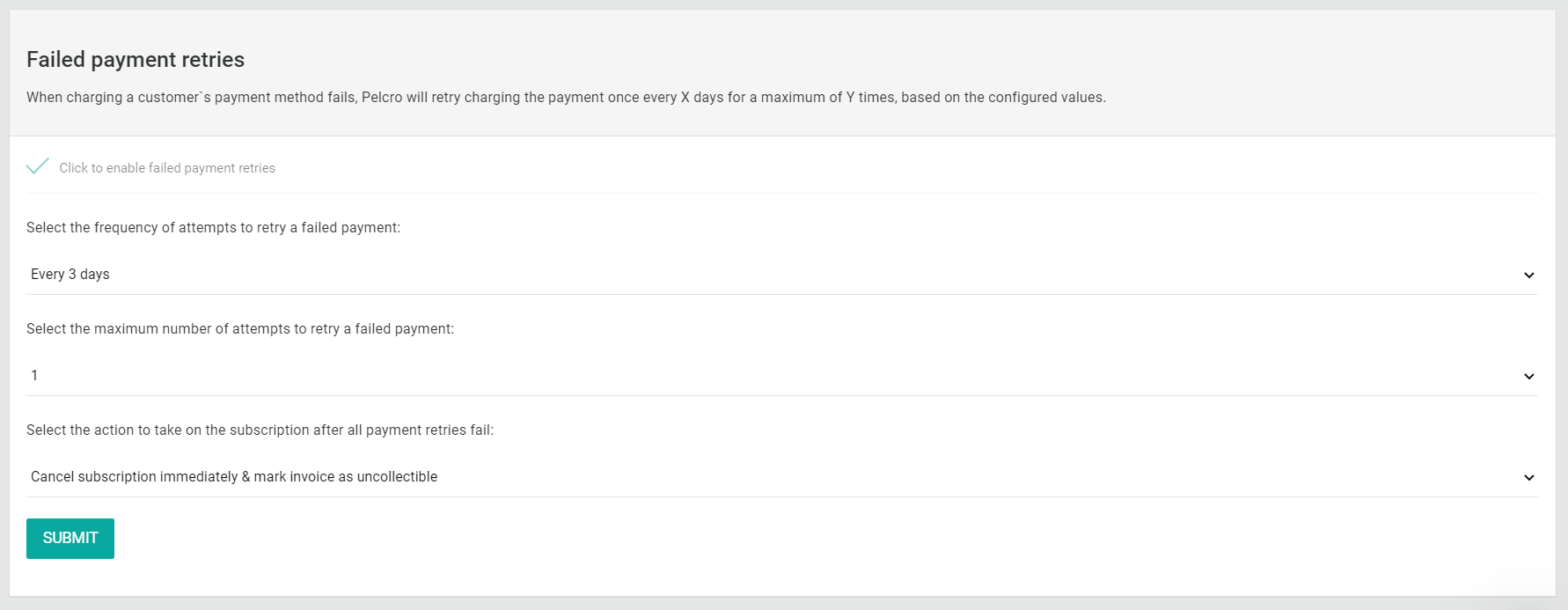
When the option for "Failed payment retries" is enabled within billing settings for your site, Pelcro will attempt to retry your customer’s credit card based on the specified settings if we receive a response from your payment gateway indicating that the card cannot be successfully charged due to a soft decline (when retrying the card at a later date may work). The rules for payment retries are specified based on the following settings:
- Frequency of retry attempts: The #days between each payment retry attempt. This can either be 3, 5 or 7 days.
- Maximum number of attempts: The #retry attempts for charging the credit card. Pelcro can retry payments for up to 5 attempts.
- Action to take after all payment retries fail: The action which will be taken on the subscription/invoice when the payment retries have been exhausted. This can either be:
- Cancel subscription immediately and mark invoice as uncollectible
- Leave subscription active and keep invoice as open
For example, if you apply the following settings:

Pelcro will retry charging the payment once every 3 days, for a maximum of 3 attempts, after which Pelcro will stop attempting to collect payment on your behalf, the subscription is cancelled immediately, and the invoice is marked as uncollectible.
Note that if the Automatic uncollectible setting is enabled:
- If the action is configured to leave subscription active and keep invoice as open, then the subscription/invoice will remain in their current respective statuses until the configured setting for automatic uncollectible takes effect.
- If the action is configured to cancel subscription immediately and mark invoice as uncollectible, then the subscription/invoice will immediately be cancelled/uncollectible, regardless of the setting for automatic uncollectible.
DISCLAIMERThis setting will override Stripe settings for payment expiration notifications.
Payment Authentication
3D-secure is an extra layer of security required by some card issuers in order to verify a purchase, usually called card authentication. Card authentication gets triggered during the subscription and e-commerce purchase process from the user interface libraries as necessary. Note that 3D secure is currently not triggered when entering a card via the platform, when updating the card from the user interface libraries and for cards requiring continuous off-session authentication for recurring subscriptions.
If authentication is not required, an attempt to make a payment is initiated immediately. If authentication is required, the end-user will be re-directed to the card issuer's website where they will be required to enter a code provided to them to complete the card authentication. Once the code is validated, the end-user will re-directed back to the normal flow and an attempt to collect the payment will be initiated. We provide testing cards for you to simulate this behavior in our testing environments.

The Strong Customer Authentication regulation in Europe requires the use of 3DS for card payments. 3DS is optional in other regions but you can still use it as a tool to reduce fraud.
Our support team is right there for you!Contact us at [email protected] and we're happy to assist with any questions or concerns.
FAQ
How are payment methods handled when adding them through the website or platform?
- If the customer has no existing payment methods, the newly added payment method will automatically be set as the default.
- If the customer already has existing payment methods, the newly added payment method will not be set as the default.
- You can still use the "Set as default" when adding the payment method to set it as the default regardless of whether the customer has existing payment methods.
- When can't I delete a payment method?
You cannot delete a payment method if:- It's tied to active subscriptions (including those canceling at period end).
- It has open or past due invoices for existing subscriptions.
Updated 6 months ago
